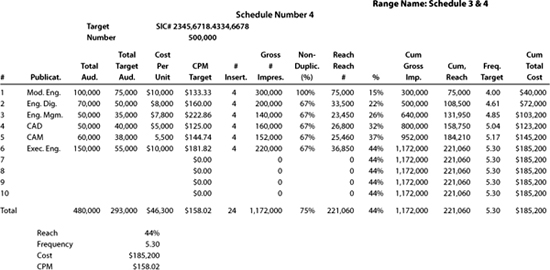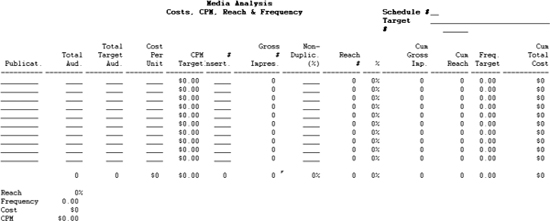9 The Advertising Plan
There are four separate aspects to an advertising plan that you must consider, as shown in Figure 9–1. You normally develop your two strategies and two plans before you write your objectives. We will discuss objectives at the end of the chapter.
Figure 9–1 Components of an advertising plan.
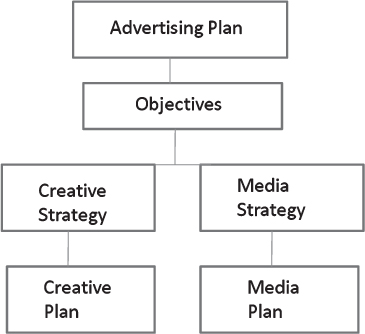
Let’s start with the creative strategy. The creative strategy does not write the ad, but gives you guidance for developing the advertising and serves as a research tool to test whether your communications are on target. The creative strategy is normally written by the creative people in the advertising department, but it applies to all your communications to the customer. In Chapter 4 we talked about customer analysis, and it’s vital that the analysis be done before you write your creative strategy.
The following eight statements express the creative strategy governing a successful outreach program warning the general public about the dangers of melanoma:
1. Objective: Encourage people to avoid sunburn.
2. Target: Teen sun worshippers.
3. Buying decision: Teens, moms, manufacturers, health professionals, clubs, schools.
4. Purpose: Use SPF 15+.
5. Promise teens: Be more attractive to the opposite sex. Promise moms: It’s safe to stay in the sun longer. Promise manufacturers: Increased sales.
6. Support: SPF 15+ blocks most harmful rays (ACS, authority).
7. Personality: Healthy, effective, savvy, fun, contemporary.
8. Timing: Pre- and early tanning season (some continuous).
Notice that there are different selling lines for different targets—one for the end user (teens), one for the buyer (mom), and one for the trade. The original selling line for teens was, “It keeps you alive.” Through research they discovered this did not turn teens on. Research revealed the clincher was, “Be more attractive to the opposite sex.”
A few years ago, I did some consulting work for a privately held major stock brokerage company. Its promotional approach appeared to be off target, and when I told the managers this, they stated that the chairman of the board really liked the advertising campaign. In fact, he had each ad framed in his office. The chairman was then called into the meeting to hear the reasons the promotional activity should be canceled. He replied that there was a misunderstanding of the objective of the advertising campaign. He compared it to a United Technologies campaign. The United Technologies campaign says nothing about the product or service but addresses various issues that the company believes would be of interest to the reader. Each time a new ad appears, the company gets thousands of requests for reprints. The basic thrust for one ad that received over 10,000 requests for reprints made reference to the common phrase “my girl.” The ad was addressed to males, and it queried why, when somebody called, males would say, get back to my girl, or call my girl for this, or have my girl do that. The copy went on to say, “Doesn’t that girl have a name? Mary? Sue? Joanne? Then why don’t you refer to her as Mary, Sue, or Joanne?”
I asked the chairman if he was familiar with the Boeing campaign featuring the 767s. The chairman replied that yes indeed, he was familiar with that campaign, and it was another example of what he was trying to do. He referred to this type of activity as “selling image.” The problem here is that neither United Technologies or Boeing is selling image. What they are selling is their stock. And his company had no stock to sell.
The reason I bring up this story is to illustrate a common mistake in communications: that image in itself sells something. If by image you are referring to AFLAC’s duck, then you are on target. However, if by image you are referring to your company or corporation, remember that the only time people buy companies is when they buy stock. At all other times they are buying a product or service.
As discussed in Chapter 4, Customer Analysis, you always want to lead your communications with a benefit and then support it with the features of your product or service. Figure 9–2 is a reproduction of an ad for Memorial Sloan-Kettering Cancer Center. It is a very unusual presentation of a letter addressed to Cancer, “Cancer, You said I’d never bear children. My daughter says you’re wrong.” That’s a powerful headline. (Another thing I like about the ad is that they didn’t use a fashion model.)
Figure 9–3 is a reproduction of an ad for Intuit Quick-Books. It’s not a fancy ad, but I believe it appeals to every small business owner or manager. With a photo of business papers all over the floor, the headline reads, “Get your business off the ground.” Quick and to the point.
Figure 9–4 is a reproduction of an ad for Chubb Insurance. Most insurance ads I see lead with the features of the policies. Not this one. As the canoe and man is about to fall off a falls, the headline reads, “Who insures you doesn’t matter. Until it does.”
I hope you noticed that on all three of the above ads, you just have to read the headline to get the benefit. Now look at the ad in Figure 9–5, which is like so many I see. The headline is, “You say obsessive like it’s a bad thing.” Please tell me what they are selling here, because I don’t know. If you read the body copy, they do actually tell you what they are talking about, but always remember that only 10 percent of the people who read the headline read the body copy. (This statistic is based on several readership research studies conducted through the years.)
When you are able to develop an effective campaign, you should stick with it. I don’t understand why United Airlines no longer uses their selling line, “Fly the friendly skies of United” with the beautiful accompanying music, in their advertising. It used to have the highest awareness level of any campaign. At least the pilots know better, because they still say, “Thanks for flying the friendly skies.” The problem probably was that the creative people who developed the campaign thought they were not doing their job if they didn’t come up with a new story. Well, I can’t tell you what United is now saying in their ads. Can you tell me? See how memorable?
Figure 9–2 Ad for Memorial Sloan-Kettering Cancer Center.

Figure 9–3 Ad for Intuit QuickBooks.

Figure 9–4 Ad for Chubb Insurance.
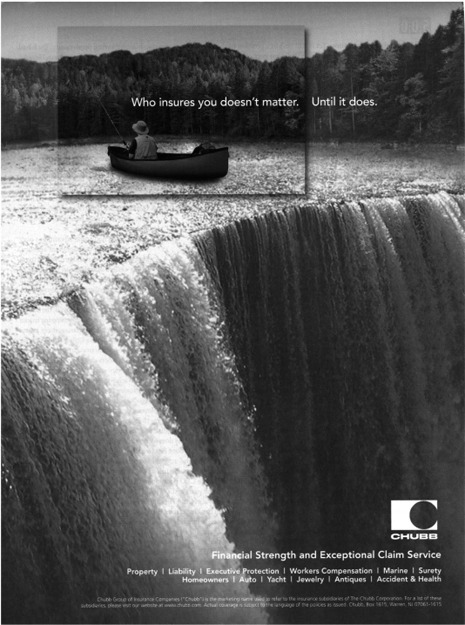
Figure 9–5 Ad for Ford Taurus.

In your campaign, each of your ads should say basically the same thing. A common mistake is for a company to run an ad on let’s say manufacturing one month and something totally different the next. How on earth does that happen? Well, the creative people say, “Hmmm, what haven’t we talked about for a while? Oh, I know, let’s now run an ad about our sales team.” That is not the way to obtain maximum awareness.
The advantages of advertising is that it is the best tool for building awareness; television is an excellent reach medium; radio a good frequency medium; print a good rifle approach; outdoor offers the lowest cost per thousand; and the Internet can probably do all the above. The disadvantages are it takes a long time to work; it can be costly; and there is a lot of bad creativity.
You are about to write your creative strategy, so keep in mind that it:
1. Defines target audience in demographic as well as psychographic terms.
2. Formulates major benefits or positioning of product or service, along with copy points.
3. Does not “write” the ad, but provides direction for writing an effective ad.
4. Must provide sufficient direction to allow evaluation of ads and ad campaigns in all media.
Following is a worksheet you can use to write your creative strategy; photocopy this or print out a copy from your folder of downloaded worksheets.
Worksheet 9–1 Creative strategy
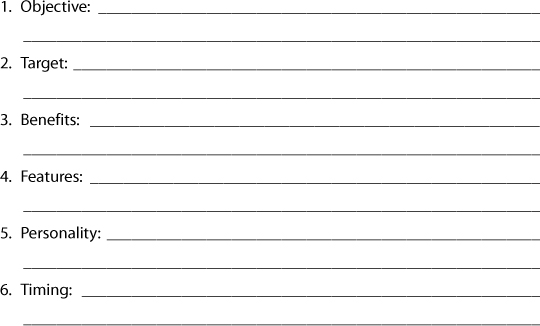
After you complete your creative strategy, you should give a copy (hand-delivery is best, but e-mail will do) to everyone who communicates with the customer.
Media Strategy
In your media strategy, you want to describe how you are going to reach each individual in the purchase process. You may need some research to find out how each one obtains their news or communicates with others. Most individuals use more than one media, but if you’re going after executives, it may be newspapers or certain magazines. For mom and dad, it may be television or radio. For the younger generation, it may be the Internet, cell phones, or TV. Mediabrands, an ad-buying unit of the Interpublic Group, just introduced a new unit called Geomentum. Geomentum plans to be able to allocate your ad budget among the 40,000 ZIP codes in the United States, sometimes zeroing in on even smaller areas, like a city block.
Outdoor advertising gives you the lowest cost per thousand (CPM), with the national average being about $1.80 per thousand viewers. You can have thirty-sheet posters or painted bulletins, which are even larger. The New Jersey Nets recently bought a painted bulletin right outside of Madison Square Garden so that Madison Square Garden management could see the ad right outside of their windows—funny, and effective. The Knicks are no doubt fuming.
Outdoor advertising can be very effective if used correctly. Keep your message to between four and six words, in huge type. Most advertisers do not do this and it is impossible to read their message as you zoom by in your car. Posters are bought by the number of showings, with “a 100# showing” meaning that the gross number of impressions will be equal to the population of the city or area. That doesn’t mean every person will see one of your posters because many people, who drive or walk by daily in certain areas, will see one of your posters several times. But the takeaway message is that outdoor delivers a very high frequency of viewers.
If your selling line incorporates full-color artwork or photography, you may want to consider mass circulation magazines, as long as they reach your target audience. Magazines are losing circulation due to all the activity on the Internet, so you now can get a good price break on your ad. Most magazines offer regional buys, so you don’t have to be national to participate. Magazine advertising also enables you to have a Starch report, which is an inexpensive way to have your ad critiqued. Starch reports are discussed in Chapter 17, The Research Plan.
If your selling line includes sound, radio could be a good choice. Radio is a frequency medium, reaching a relatively small group many times. Stations have good research on their audiences, so if you can match up your target, it could be a go.
Newspapers, like magazines, are losing circulation. I take three daily papers, the local one plus the Wall Street Journal and the New York Times. However, there is just one other house on the block that has a paper delivered. Although young people are not into newspapers, they still can be an effective advertising medium if your target is business executives or you are selling retail. If you’re going to run a newspaper campaign, you always want to talk to the editorial people first about having them give you some free publicity in a news article about your product or service. Ironically, you will probably get more feedback from the news article than your ads.
Television is the most effective advertising medium because it combines sight and sound, but it’s expensive. However, like newspapers and magazines, rates are coming down due to all the action on the Internet, including programs, movies, and advertising. In fact, some of the local stations will shoot your commercial for you at a very reasonable rate. It won’t compare with those produced by the commercial production houses, but if your story is simple, it may work. Don’t overlook ten-second ID commercials. You can have them produced by the pros for a fraction of the cost of a thirty-second spot. A client of mine in San Diego was a local potato chip manufacturer who was competing against Granny Goose potato chips. I came up with the idea of a talking potato chip and had the ID shot in Hollywood. It kept my client competitive with his national competition.
You also want to check your advertising “weight.” That means you will have to look into reach and frequency. Frequency is the number of times you reach the same individual (and past advertising research states the minimum should be five; the optimal range is between five and ten). The period of time you have to reach your minimum varies by media. For outdoor, daily newspapers, radio, television, and the Internet, it’s a month; for weekly magazines it’s three months; and for monthly magazines, a year.
Reach is the percent of your target audience that you reach at least once. When we get into your advertising plan’s objectives, as we will later, you may have an awareness objective of 50 percent of the target audience. If that is true, you would need a reach figure of approximately 70 percent, because not all of your target will remember your ad.
The equation for reach and frequency is as follows:

Media Plan
Following are two of the four schedules in the reach and frequency case history.
Schedule 1 (the upper half of Figure 9–6) consists of fourteen insertions in four magazines, delivering a frequency of 4.57 (second to last column on the right) and a reach of only 32 percent (fifth column from the right). The information on how the number of times you reach the same individual comes from either the media itself or media research companies. If you are working with an advertising agency, the agency will supply this data.
Figure 9–6 Media analysis: Reach and frequency, CPM, and total cost; schedules 1 and 2 (CRF; range name: Schedule1&2).
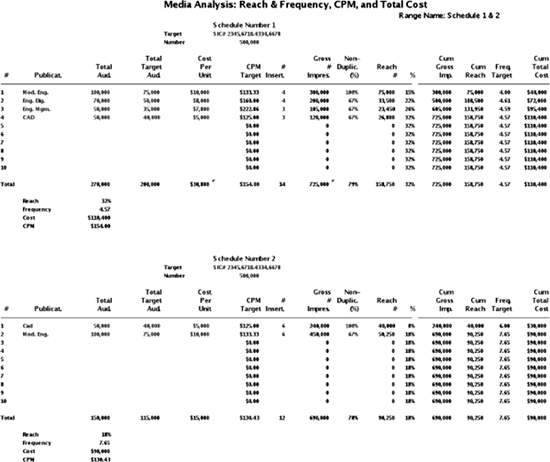
Schedule 1 is clearly a weak schedule, so let’s go to schedule 2. This one consists of twelve insertions in two of the magazines. This increases your frequency to 7.65, but the reach drops to just 18 percent. Now we will go to schedules 3 and 4, shown in Figure 9–7, from the same Excel file, to see if we can do better.
In schedule 3, we have the same magazines as in schedule 1, but the number of insertions has been increased to twenty-four. This gives us a frequency of 7.56, but only increases the reach to 32 percent. On schedule 4, we have added two more magazines and kept the insertions at twenty-four. This gives us a frequency of 5.30 and the reach increases to 44 percent. This is not a bad schedule if your objective is a relatively low awareness goal of say around 30 percent. If your objective is higher, then you have to increase the number of magazines you are using or add another type of media.
To give you an idea of how you might do, use your downloaded file “RF.xlw,” and fill in the data for a magazine ad distribution schedule that you might want to try. Only fill in your data where you see blue lines or zeros. Although only the first two schedules are shown in Figure 9–8, the electronic file allows four variations, as you saw in Figures 9–6 and 9–7 above.
The above media analysis file can also be used for radio, TV, and even the Internet. You just insert the number of spots in place of the number of insertions.
Outdoor advertising has the lowest CPM, only $1.80 to reach a thousand people. Mass audience magazines, such as People, command the second lowest at $3.00. Next comes radio at $3.50 for a thirty-second commercial, followed by television at $6.00 for an early evening spot. However, TV can be expensive because it takes about fifteen spots per week for four weeks to obtain a frequency of 4—but the reach is around 80 percent. Newspapers are next most expensive at a CPM of $9.00, and trade magazines for men top our list at $12.00.
Figure 9–7 Media analysis: Reach and frequency, CPM, and total cost; schedules 3 and 4 (CRF; range name: Schedule3_&4).

Your media analysis: Range and frequency schedules 1 and 2 (RF; range name: Schedule1&2).

Creative Plan
The creative plan—not the creative strategy—is the actual advertising itself. Lead with the benefit, supported by the features. As I said in an earlier chapter, when it leaves the factory, it’s called lipstick; when it is bought by the customer, it’s called hope. In print advertising, the features belong in the body copy. Don’t use reverse type or it will cut your readership by up to 80 percent. Try not to be too cute. Sometimes it’s a problem understanding what the gecko says in the Geico television ads.
You want to test your ads or communications at various junctures, as shown in Figure 9–9, which shows a flow chart of the creative development process.
It seems clear to me that much advertising is pretty close to worthless. It’s a wise investment of research dollars to be sure you are on target.
A management tool you may want to consider for your entire marketing team comes from an article in the Raleigh, North Carolina, News & Observer about McKinney, an advertising agency in Durham, North Carolina. Management felt it was important that employees run into one another and chat, as the average conversation can quickly turn into a creative epiphany. As a result, the mailroom and mailboxes now lie adjacent to a spacious café where employees gather to get a cup of coffee, grab a bite to eat, or catch up on the latest quirky news posted on a nearby magnetic board. But the café is not just for eating. An enormous white onyx table stretches the length of the room and has hosted everything from Mellow Mushroom pizza parties to exquisite catered events. Additional seating nearby and officewide Wi-Fi gives “McKinneyites” a chance to work wherever they are the most productive. And in many cases, it’s in between conversations, right by the mailroom.1 This approach could make your entire marketing team become closer and work better together.
Figure 9–9 Creative development testing timeline.
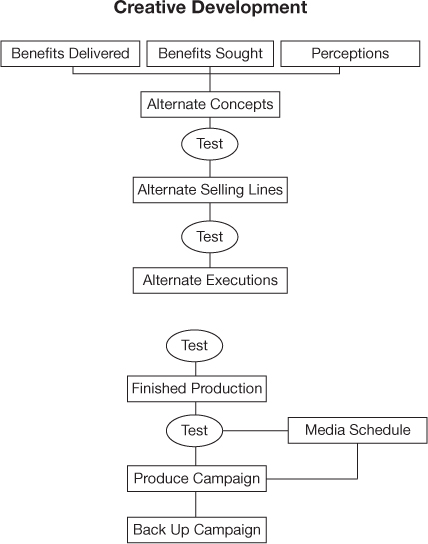
Objectives and Strategies
Following is a worksheet for your advertising plan objectives and strategies. Photocopy this or print out a copy from your downloaded Worksheets folder. You can write over my terminology, but I inserted those categories to give you an idea what you should be measuring for.
Worksheet 9–2 Advertising plan: Objectives and strategies

Note
1. Alli Soule, “Mailroom, Café Foster Chats,” News & Observer, July 26, 2009.

